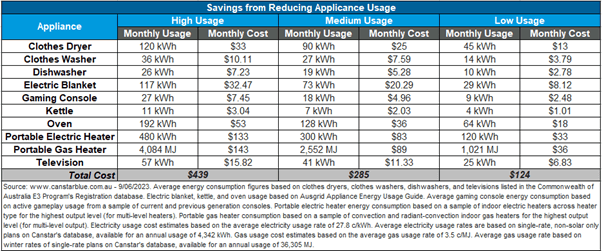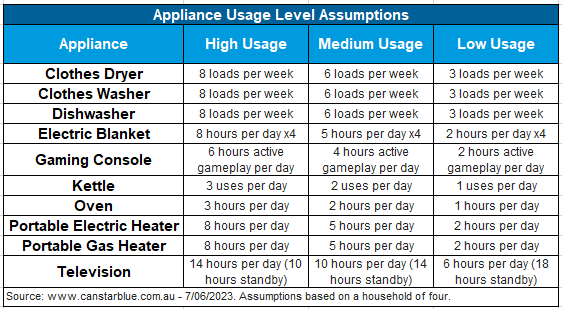Families worried about the rising cost of energy could save more than $300 this winter with changes to how often the household uses some common appliances, Canstar Blue research found.
The research looked at appliances that typically get a workout in the chilly months, ranging from portable heaters and electric blankets that make for a cosier living room or bedroom to clothes dryers that come in handy when it’s wet outside and even gaming consoles that help pass the time when the weather isn’t great for going out.
The research showed that big cuts to the hours of use of a range of appliances could add up to a saving of as much as $315 in running costs, while dropping down even a few hours of use could still add up to a saving of about $160.
How appliances impact your electricity costs
For example, running a portable electric heater for eight hours each day could cost $133 a month, but cutting the running time to five hours a day reduced that cost to $83, Canstar Blue’s research found.
Putting eight loads of washing through the clothes dryer each week added up to a monthly running cost of $33, while dropping to five loads a week cut the cost to $25 and three loads a week to $13.
Tara Donnelly, Canstar Blue’s Utilities Editor, said that while making the whole suite of changes may not suit every household, particularly those living in colder climates where heating is a necessity, the findings highlighted some money-saving options families could consider, depending on their circumstances.
“While there are some appliances a family can’t avoid using, such as the fridge, other appliances are more of a luxury that saves time or adds comfort or entertainment – portable heaters, electric blankets … even TVs and gaming consoles. But reducing household use of these nice-to-have appliances by a few hours per day or week can add up to significant savings each month,” she said.
“And if you don’t want to slash the amount of time you use your favourite ‘winter warmers’ or time-savers, you can opt for a middle ground – it’s still possible to save roughly $160 a month by shaving off a few hours of heater use or putting a few fewer loads through the dryer.”
Ms Donnelly said that there also were simple ways to make portable heating more effective without reducing the hours of use, such as ensuring draughts were blocked and closing curtains to limit the amount of heat escaping from a room. Using a heater with a thermostat, so it turned off when the desired temperature was reached rather than overheating the room, was another potential money-saver, as was using a portable heater to warm smaller spaces, such as a bedroom, rather than a large loungeroom. Investing in a more energy efficient heater may not be viable for all families’ budgets but could provide a saving on running costs over the longer term.
“It’s worth noting, too, that the biggest savings on energy usually come from paying the lowest possible rate for energy itself, so if you can’t remember when you last compared energy plans, it might be time to do so,” she added.
How much cutting appliances running times can save
The table below shows the potential savings a household of four people could make by making significant, or more moderate, reductions in their use of some common winter appliances.

The table below shows the assumptions Canstar Blue made about the hours or ways a household of four people may use those appliances, to determine what constituted high, medium and low usage habits.

Smaller savings for thrifty households
While some appliances could make a considerable difference to a household’s energy bill, depending on how often and for how long they were used, others offered smaller savings, Ms Donnelly noted.
“For example, cutting how long you run your oven from three hours per day to one hour saves about $35 a month,” she said. “And using the TV for six hours a day, rather than having it playing in the background for 14 hours, will reduce usage costs by about $9 a month.
“Heating water in the kettle once a day, then using that water from a thermos rather than re-boiling the kettle, will save about $2 a month, so that’s probably a change only super-thrifty households would want to consider.”
The research came as electricity consumers in south-east Queensland, New South Wales, Victoria and South Australia braced for electricity price increases starting on July 1.
What’s happening with energy prices?
The Australian Energy Regulator, which regulates energy prices in SEQ, NSW and SA, and the Essential Services Commission, which regulates prices in Victoria, revealed in May how much energy companies would be permitted to increase prices on standing-offer electricity plans. These are the plans provided to Australians who don’t engage with the energy market by opting for a market-offer plan.
Single-rate, standing offer residential customers in Victoria will see their bills go up by 25% from July 1, equal to an $352 increase in the average annual price of a plan. South Australians on the same type of plan will experience a 23.9% or $439 rise and south-east Queenslanders a 21.5% or $349 jump. Across all three of New South Wales’ distribution networks, prices are set to rise by between 20.8% and 21.4% or as much as $435 on single-rate, standing-offer residential plans.
These so-called default prices usually set the tone for how energy companies price their market offer plans too. Two of Australia’s biggest energy companies, AGL and Origin, have already announced price increases of up to 29% for customers on market-offer plans in those states.
Households that are struggling to pay their energy bills have been encouraged to contact their energy provider. Power companies must have hardship policies that outline how they will help Australians manage their energy costs. States and territories also offer a range of energy rebates and concessions for vulnerable householders.

Share this article